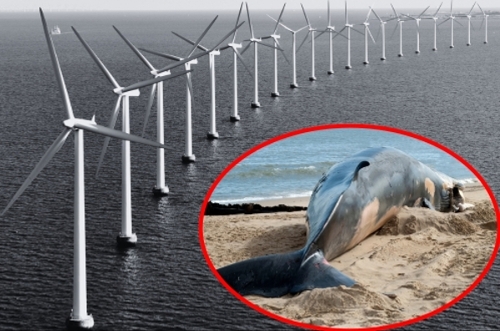
Offshore Wind is Killing Whales
New Evidence Reveals How Construction Noise and Seismic Testing Are Leading to Whale Deaths
By David T. Stevenson
Center for Energy & Environmental Policy
July 25, 2024
We have patiently waited for indisputable evidence that offshore wind is killing whales despite federal agencies repeatedly stating that no such evidence exists. It does now. Recent real-time acoustic tests of project construction noise and seismic testing reveal noise levels far exceeding those that result in whale mortality.
Furthermore, we now have scientific evidence that connects seismic testing used in seabed exploration with the increased whale deaths, which federal agencies describe as "unusual mortality events." Even the noise from the operating turbines may exceed safe levels, posing an ongoing threat to the whales.
To understand how these noise levels are generated, it's important to look at the technology used in offshore wind surveys. Offshore wind survey vessels utilize high-energy "sparkers" to map geological features of the seabed. The sparkers emit acoustic pulses that travel into the ocean floor and are then reflected back to receivers on the vessels.
Rand's Acoustic Study Findings
In 2023, Robert Rand, an acoustic consultant, conducted a study of the sonar noise generated by the Miss Emma McCall survey vessel off the coast of New Jersey. He discovered that the sound at the source was 224 decibels. As sound waves travel away from the source, their strength decreases. But half a nautical mile away, Rand recorded peak sound levels at 151.6 decibels.
These findings are alarming and have significant implications for marine life, particularly whales. The National Marine Fisheries Service (NMFS), a division of the National Oceanic & Atmospheric Administration (NOAA), states that whales and other marine mammals can temporarily lose hearing at 152 decibels of continuous sound (or root-mean-square levels) and permanently lose hearing at 173 decibels (NOAA Fisheries, 2018; NOAA Fisheries, 2020). Loss of hearing leads to death as whales travel, communicate, and find prey through echolocation.
NOTE: Each 10-decibel increase is ten times louder, so 130-decibels is ten times louder than a music concert (120-decibels), and 152-decibels is over 1,000 times louder than a concert.
Rand also measured sound levels during the construction of the Vineyard Wind project off Nantucket Island by the vessel Orion. Even with advanced noise-mitigation techniques, pile driving noise had impulsive peak noise levels measured up to 180 decibels over 1 kilometer away and root-mean-square levels over 160 decibels at over 3.3 kilometers. The continuous noise generated by vessel propulsion and dynamic positioning thrusters significantly surpassed the federal threshold for behavioral harassment, with noise levels exceeding 120 decibels out to over 6 kilometers.
These levels cause hearing impairment or loss. The NMFS issues Letters of Authorization for Incidental Take of whales and other marine animals for offshore wind construction projects. The detected noise levels exceed the allowed noise caps.
Gerasoulis's Statistical Analysis
Apostolos Gerasoulis, a Rutgers professor emeritus of computer science, is quoted in both Climate Change Dispatch and the Daily Mail saying, "Absolutely 100 percent offshore wind kills whales." In these publications, he highlights a direct correlation between the increase in whale deaths and the increase in offshore wind project seabed testing.
For example (see Table 1), in January and February 2022, survey vessels covered 4,213 miles off the New York and New Jersey coasts, and one whale died. During the same months in 2023, vessels covered 11,977 miles, and seven whales died. In August 2022, vessels covered 5,469 miles, and no whales died. In August 2023, vessels covered 16,812 miles, and six whales died.

Gerasoulis divided his data into two samples and subjected the samples to two sophisticated statistical tests. Both indicated that the difference in whale deaths before and after offshore wind surveys started was statistically significant and not random.
Some posit that increased container ship traffic may have caused the increase in whale deaths. However, Gerasoulis found that in 2020-2021 (see Table 2), container ship traffic was up 18 percent, and whale deaths were down 92 percent. However, in 2022-2023, container ship traffic was down 18 percent, and whale deaths were up 162%. There is no correlation between container ship traffic and whale deaths.

CONCLUSION
Sufficient scientific evidence proves offshore wind survey work and construction are killing whales. The first projects with massive new turbines never used before are moving into operation. Acoustic data is being accumulated and likely will show that safe operational noise levels are being exceeded daily. The North Atlantic Right Whale is on the endangered species list with a critical status of only 328 individuals remaining.
According to an NMFS report, "The species faces a high risk of extinction ... the loss of even one individual a year may reduce the likelihood of species recovery and of their ability to achieve optimum sustainable population."
All survey and construction work on offshore wind projects must cease now before these majestic creatures disappear forever.